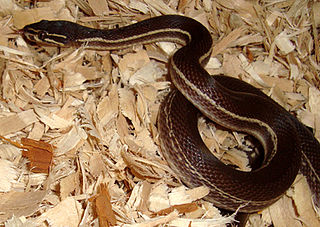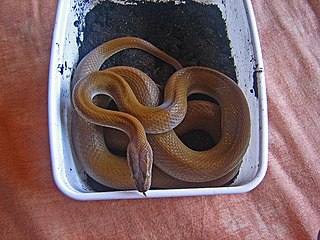
Holaspis is a genus of equatorial African lizards in the family Lacertidae. These lizards are capable of gliding flight for distances of 30 meters.

Leptopelis is a genus of frogs in the family Arthroleptidae. They are found throughout Sub-Saharan Africa, excluding Madagascar. It is placed in monotypic subfamily Leptopelinae, although this subfamily is not always recognized. They have a number of common names, including forest treefrogs, tree frogs, leaf-frogs, and big-eyed frogs.

The Natricinae are a subfamily of colubroid snakes, sometimes referred to as a family (Natricidae). The subfamily comprises 36 genera. Members include many very common snake species, such as the European grass snakes, and the North American water snakes and garter snakes. Some Old World members of the subfamily are known as keelbacks, because their dorsal scales exhibit strong keeling.
Dromophis is a genus of colubrid snakes. There are two commonly accepted species in the genus Dromophis:
Letheobia is a genus of blind snakes in the family Typhlopidae.
The striped swamp snake, also known as the African swamp snake, is a species of colubrid snake. It is one of two members of the genus Dromophis. It is found in several African countries, including Burkina Faso, Senegal, Guinea-Bissau, Mali, Ivory Coast, Togo, Ghana, Benin, Niger, Nigeria, and Cameroon.

Lycodonomorphus is a genus of snakes commonly referred to as African water snakes. They are small, nonvenomous snakes, with all members being endemic to Africa, especially Tanzania.

Aubry's flapshell turtle is a species of softshell turtle in the family Trionychidae. The species is endemic to Central Africa.
Polemon gabonensis, or the Gaboon snake-eater, is a species of mildly venomous rear-fanged snake in the family Atractaspididae. It is endemic to Africa.
The Gabon beaked snake is a species of blind snake in the family Typhlopidae. It is endemic to Sub-Saharan Africa. It is known from Gabon, Cameroon, the Republic of the Congo, the Democratic Republic of the Congo, and Ghana. However, the identity of different populations is not fully clear.

Boaedon is a genus of African lamprophiids consisting of the "brown" house snakes. The genus was originally described by Duméril but the species contained were reclassified as Lamprophis by Fitzinger in 1843, this taxonomy remained widely accepted until November 2010 when a phylogenetic study was published by C.M.R Kelly et al. who resurrected the Boaedon clade. Although commonly regarded as belonging to the Colubridae, primary literature usually lists them and related species as belonging to the family Lamprophiidae within the superfamily Elapoidea, which includes the venomous cobras and mambas.

The Lamprophiidae are a family of snakes found throughout much of Africa, including the Seychelles. There are 89 species as of July 2022.

The large-eyed green tree snake, also known commonly as the splendid dagger-tooth tree snake, is a species of venomous snake in the family Colubridae. The species is endemic to Africa. There are three recognized subspecies.

The olive marsh snake is a species of snake in the subfamily Natricinae of the family Colubridae. The species is endemic to Sub-Saharan Africa.

Toxicodryas blandingii, commonly known as Blanding's cat snake and Blanding's tree snake, is a species of rear-fanged venomous snake of the family Colubridae. The species is endemic to Sub-Saharan Africa.

Lamprophiinae is a subfamily of lamprophiid snakes, a large group of mostly African snakes, most of which were formerly classified as colubrids but which we now know are actually more closely related to elapids.

The black file snake, also known commonly as the dwarf file snake or the Nyassa file snake, is a species of snake in the subfamily Lamprophiinae of the family Lamprophiidae. The species is endemic to Africa.
Limaformosa is a genus of snakes, commonly known as file snakes, in the family Lamprophiidae. The genus is endemic to Africa.













